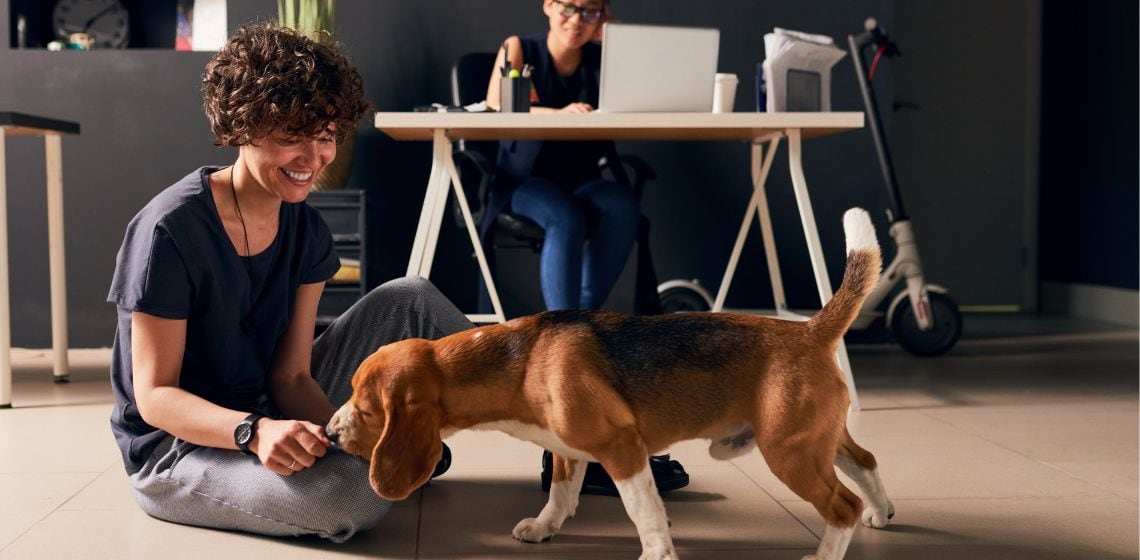Table of Contents
Assess your dog’s suitability
Before deciding to bring your dog to work, evaluate if your dog is suitable for the office environment. Consider your dog’s temperament, behavior, and training. Dogs that are well-socialized, obedient, and calm are generally better candidates for office settings. Puppies or dogs with anxiety, excessive barking, or aggression issues might not thrive in a busy work environment and could disrupt your colleagues.
Check workplace policies
Every workplace has different policies regarding pets. Ensure you are familiar with and adhere to your company’s pet policy. Some workplaces may require proof of vaccinations, insurance, or a behavioral assessment. Additionally, check if there are specific areas where pets are allowed or restricted, such as break rooms or client meeting spaces.
Communicate with colleagues
Communication with your coworkers is crucial. Notify them in advance about your intention to bring your dog to work. This allows colleagues who might have allergies, phobias, or other concerns to voice them beforehand. It’s essential to be respectful and considerate of everyone’s comfort and well-being.
Create a comfortable workspace for your dog
Set up a designated area for your dog where they can feel safe and comfortable. Bring a bed, blanket, and some favorite toys to help them settle in. Ensure there’s access to water and a place for them to relieve themselves. Having a familiar, cozy spot will help your dog feel more secure and less anxious in the new environment.
Bring the essentials
Pack a bag with all the essentials your dog will need throughout the day. This includes:
- Food and treats: Maintain your dog’s regular feeding schedule.
- Water and bowl: Keep your dog hydrated.
- Leash and harness: For walks and necessary control.
- Waste bags: Be prepared to clean up after your dog.
- Toys and chews: To keep them occupied and entertained.
- Medical records: In case of an emergency.
Ease your dog into the new environment
Gradually acclimate your dog to the office environment. Start with short visits to let them explore and get used to the sights, sounds, and smells. Monitor their reactions and slowly increase the duration of their stays. This gradual introduction helps reduce anxiety and allows your dog to adjust more comfortably.
Maintain good hygiene
Good hygiene is essential when bringing a dog into the workplace. Regular grooming helps reduce shedding and odors. Bathe your dog regularly and keep their coat brushed and clean. Make sure your dog is free of fleas and ticks. Additionally, always clean up after your dog promptly to maintain a clean and pleasant work environment.
Train for office etiquette
Training your dog for appropriate office behavior is crucial. Basic commands like sit, stay, come, and quiet are essential. Train your dog not to jump on people, chew on office furniture, or bark excessively. Positive reinforcement techniques can be highly effective in teaching your dog the appropriate office etiquette.
Plan for breaks
Your dog will need regular breaks throughout the day for bathroom needs, stretching, and exercise. Schedule regular walks to keep them physically and mentally stimulated. These breaks are also beneficial for you, providing an opportunity to stretch and take a breather from work. Make sure you adhere to a consistent schedule to establish a routine for your dog.
Be prepared for emergencies
In case of emergencies, have a plan in place. Know the location of the nearest veterinary clinic and have a pet first aid kit on hand. Ensure that your dog’s identification tags are up-to-date with your contact information. Having a backup plan for someone to take care of your dog if you have to leave suddenly can also be very helpful.
Respect your dog’s needs
Pay attention to your dog’s needs and comfort. If your dog shows signs of stress or discomfort, such as excessive panting, pacing, or whining, it might be best to take them home. Not all dogs are suited for office life, and it’s important to prioritize their well-being over the convenience of having them at work.
Foster a pet-friendly culture
Encourage a pet-friendly culture in your workplace by setting a good example. Respect the rules, keep your dog well-behaved, and maintain open communication with your colleagues. This can help create a positive and inclusive environment where pets are welcomed and enjoyed by everyone.
Evaluate and adapt
Regularly evaluate how the arrangement is working for you, your dog, and your colleagues. Be open to feedback and willing to make adjustments if necessary. Flexibility and adaptability are key to ensuring a successful and harmonious experience for all involved.
Bringing your dog to work can enhance your work-life balance and contribute to a more positive and relaxed office atmosphere. By carefully considering your dog’s suitability, respecting workplace policies, and preparing adequately, you can create a successful and enjoyable experience for both you and your dog. Remember that patience, communication, and a proactive approach are essential in making this endeavor a success. With the right preparation and attitude, bringing your dog to work can become a rewarding and enriching experience for everyone involved.

Emily is a veterinary technician with over 6 years of experience in the field. She knew since she was a child that she was meant to work with animals. She started her career working in veterinary ophthalmology and has since worked her way to general practice. Emily now works as a surgical technician working in the operating room. When not at work, Emily spends her time with her husband and her small zoo of 3 dogs, 4 cats, 5 ducks, and 5 chickens.








